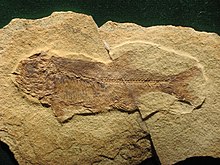
Hiodontiformes is an order of ray-finned fish consisting of the two living species of the mooneye family, Hiodontidae, and three extinct genera.

Hiodontidae, commonly called mooneyes, is a family of ray-finned fish with a single included genus Hiodon. The genus comprise two living species native to North America and three to five extinct species recorded from Paleocene to Eocene age fossils. They are large-eyed, fork-tailed fish that superficially resemble shads. The vernacular name comes from the metallic shine of their eyes.

Florissantia is an extinct genus of flowering plants in the Malvaceae subfamily Sterculioideae known from western North America and far eastern Asia. Flower, fruit, and pollen compression fossils have been found in formations ranging from the Early Eocene through to the Early Oligocene periods. The type species is Florissantia speirii and three additional species are known, Florissantia ashwillii, Florissantia quilchenensis, and Florissantia sikhote-alinensis.

Amyzon is an extinct genus belonging to the sucker family Catostomidae first described in 1872 by E. D. Cope. There are six valid species in the genus. Amyzon are found in North American fossil sites dated from the Early Eocene in Montana and Washington USA, as well as the British Columbian sites at McAbee Fossil Beds, Driftwood Canyon, and the "Horsefly shale", as well as Early Oligocene sites in Nevada USA. One Middle Eocene species is known from the Xiawanpu Formation of China. The Ypresian species A. brevipinne of the Allenby Formation was redescribed in 2021 and moved to a separate monotypic genus Wilsonium.

Tilia johnsoni is an extinct species of flowering plant in the family Malvaceae that, as a member of the genus Tilia, is related to modern lindens. The species is known from fossil leaves found in the early Eocene deposits of northern Washington state, United States and a similar aged formation in British Columbia, Canada.

Dinokanaga is a small genus of scorpionfly belonging to the extinct family Dinopanorpidae. The six species D. andersoni, D. dowsonae, D. hillsi, D. sternbergi, D. webbi, and D. wilsoni have all been recovered from Eocene fossil sites in British Columbia, Canada, and Washington state, United States.
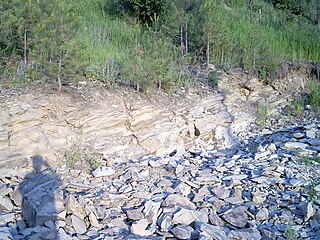
The Klondike Mountain Formation is an Early Eocene (Ypresian) geological formation located in the northeast central area of Washington state. The formation is comprised of volcanic rocks in the upper unit and volcanic plus lacustrine (lakebed) sedimentation in the lower unit. the formation is named for the type location designated in 1962, Klondike Mountain northeast of Republic, Washington. The formation is a lagerstätte with exceptionally well-preserved plant and insect fossils has been found, along with fossil epithermal hot springs.

The McAbee Fossil Beds is a Heritage Site that protects an Eocene Epoch fossil locality east of Cache Creek, British Columbia, Canada, just north of and visible from Provincial Highway 97 / the Trans-Canada Highway. The McAbee Fossil Beds, comprising 548.23 hectares, were officially designated a Provincial Heritage Site under British Columbia's Heritage Conservation Act on July 19, 2012. The site is part of an old lake bed which was deposited about 52 million years ago and is internationally recognised for the diversity of plant, insect, and fish fossils found there. Similar fossil beds in Eocene lake sediments, also known for their well preserved plant, insect and fish fossils, are found at Driftwood Canyon Provincial Park near Smithers in northern British Columbia, on the Horsefly River near Quesnel in central British Columbia, and at Republic in Washington, United States. The Princeton Chert fossil beds in southern British Columbia are also Eocene, but primarily preserve an aquatic plant community. A 2016 review of the early Eocene fossil sites from the interior of British Columbia discusses the history of paleobotanical research at McAbee, the Princeton Chert, Driftwood Canyon, and related Eocene fossil sites such as at Republic.
The Coldwater Beds are a geologic formation of the Okanagan Highlands in British Columbia, Canada. They preserve fossils dating back to the Ypresian stage of the Eocene period, or Wasatchian in the NALMA classification.

Amia? hesperia is an extinct species of bony fish in the bowfin family, Amiidae. The species is known from fossils found in the early Eocene deposits of northern Washington state in the United States and southeastern British Columbia. The species is one of eight fish species identified in the Eocene Okanagan Highlands paleofauna.

Barghoornia is an extinct genus of flowering plants in the family Burseraceae containing the solitary species Barghoornia oblongifolia. The species is known from fossil leaves found in the early Eocene deposits of northern Washington state, United States.
The paleoflora of the Eocene Okanagan Highlands includes all plant and fungi fossils preserved in the Eocene Okanagan Highlands Lagerstätten. The highlands are a series of Early Eocene geological formations which span an 1,000 km (620 mi) transect of British Columbia, Canada and Washington state, United States and are known for the diverse and detailed plant fossils which represent an upland temperate ecosystem immediately after the Paleocene-Eocene thermal maximum, and before the increased cooling of the middle and late Eocene to Oligocene. The fossiliferous deposits of the region were noted as early as 1873, with small amounts of systematic work happening in the 1880-90s on British Columbian sites, and 1920-30s for Washington sites. A returned focus and more detailed descriptive work on the Okanagan Highlands sites revived in the 1970's. The noted richness of agricultural plant families in Republic and Princeton floras resulted in the term "Eocene orchards" being used for the paleofloras.

The Eocene Okanagan Highlands or Eocene Okanogan Highlands are a series of Early Eocene geological formations which span a 1,000 km (620 mi) transect of British Columbia, Canada, and Washington state, United States. Known for a highly diverse and detailed plant and animal paleobiota the paleolake beds as a whole are considered one of the great Canadian Lagerstätten. The paleobiota represented are of an upland subtropical to temperate ecosystem series immediately after the Paleocene–Eocene thermal maximum, and before the increased cooling of the middle and late Eocene to Oligocene. The fossiliferous deposits of the region were noted as early as 1873, with small amounts of systematic work happening in the 1870–1920s on British Columbian sites, and 1920–1930s for Washington sites. Focus and more detailed descriptive work on the Okanagan Highland sites started in the late 1960s.
The paleofauna of the Eocene Okanagan Highlands consists of Early Eocene arthropods, vertebrates, plus rare nematodes and molluscs found in geological formations of the northwestern North American Eocene Okanagan Highlands. The highlands lake bed series' as a whole are considered one of the great Canadian Lagerstätten. The paleofauna represents that of a late Ypresian upland temperate ecosystem immediately after the Paleocene-Eocene thermal maximum, and before the increased cooling of the middle and late Eocene to Oligocene. The fossiliferous deposits of the region were noted as early as 1873, with small amounts of systematic work happening in the 1880-90s on British Columbian sites, and 1920-30s for Washington sites. Focus and more detailed descriptive work on the Okanagan Highlands site started in the last 1970's. Most of the highlands sites are preserved as compression-impression fossils in "shales", but also includes a rare permineralized biota and an amber biota.
Eoseira is an extinct genus of diatoms belonging to the family Aulacoseiraceae and containing the single species Eoseira wilsonii. The species is dated to the Early Eocene Ypresian stage and has only been found at the type locality in east central British Columbia.
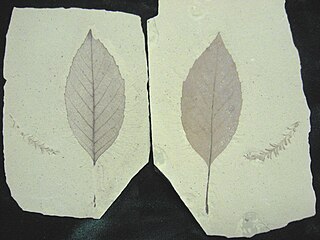
Alnus parvifolia was an extinct species of flowering plant in the family Betulaceae related to the modern birches. The species is known from fossil leaves and possible fruits found in early Eocene sites of northern Washington state, United States, and central British Columbia, Canada.
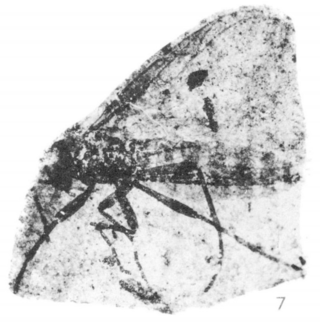
Plecia avus is an extinct species of Plecia in the March fly family Bibionidae and is solely known from Early Eocene sediments exposed in central southern British Columbia. The species is one of twenty bibionid species described from the Eocene Okanagan Highlands.
The Paleobiota of the Klondike Mountain Formation comprises a diverse suite of Early Eocene plants and animals recovered from North Central Washington State. The formation outcrops in locations across the north western area of Ferry County, with major sites in Republic, north west of Curlew Lake, and on the Toroda Creek area. The formation is the southern most of the Eocene Okanagan Highlands, sharing much of the paleoflora and paleofauna with site across Central and southern British Columbia.

Dennstaedtia christophelii is an extinct species of fern in the family Dennstaedtiaceae related to the modern hayscented ferns. The species is known from fossil fronds found in early Eocene sites of northern Washington state, United States and central British Columbia, Canada. The species is suggested to be closest to a Neotropical "Patania" clade and specifically the species Dennstaedtia producta and Dennstaedtia mathewsii.
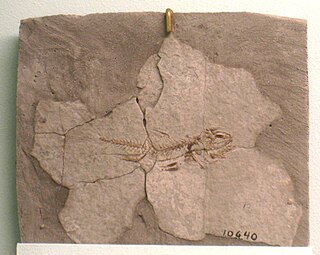
Erismatopterus is an extinct genus of percopsiform fish which lived during the early to middle Eocene epoch and containing the single species Erismatopterus levatus. A report of the genus in sediments of similar age in Washington State have been discredited. Erismatopterus is treated as part of the family Percopsidae, but formerly was the type genus of the extinct family Erismatopteridae. The genus is closely related to Amphiplaga of related lake sediments. Shoaling behavior has been reported from a mass mortality fossil of E. levatus and attributed as a predator-evasion response behavior.
